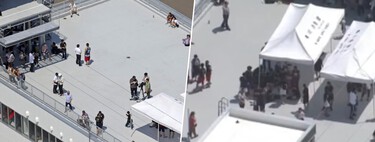Although tsunamis seem like effects that are reserved for the Japanese coasts, the reality is that Spain is also very likely to suffer an event of this magnitude on our coasts. Cádiz is one of the locations with the highest risk of suffering a tsunami in Spain, and the authorities wanted to verify that the emergency and response systems work in case this type of event occurs at any time.
In order to verify this, the authorities carried out a drill in mid-November in which the ES-Alert system, several schools and all emergency services were mobilized. And given this great display, the question is mandatory: what are the chances of a tsunami occurring in Cádiz?
Cádiz is at the center of this simulation because it is the area with the greatest danger from tsunamis in the country, due to the history behind it and the seismicity of the Azores-Gibraltar area. For this reason, the Government of Andalusia has developed an Emergency Plan for the Risk of Tsunami (PEMA) and has chosen Cádiz for the largest tsunami drill carried out in Spain.
Because. In the past, geological records indicate that at least five large tsunamis have occurred in the Gulf of Cádiz in the last 7,000 years. All of these associated with megaearthquakes at the plate boundary between Africa and Eurasia. Added to this is the historical reference: the tsunami linked to the Lisbon earthquake of November 1, 1755, which completely flooded Cádiz and part of the Andalusian coast with waves of several meters in a matter of dozens of minutes.
The paleoseismology work of the CSIC and several universities places the recurrence interval of these events between 1,200 and 1,500 years, long enough for them to be socially forgotten, but too short to be ignored in risk planning. This places the southwest of the peninsula as one of the most exposed areas in Europe to tsunamis, despite the fact that the “perceived risk” on the street has historically been very low.
And this is precisely something that has been analyzed in the layers of sand and marine remains left inland and that gives us information about what happened thousands of years ago. Although logically always with a time frame that is approximate.
Why now. The fact of doing the simulation in this month of November may make us think that scientists have found evidence that a large tsunami is coming to Cádiz, but nothing could be further from the truth. What is happening in this case is that a risk that has been known for a long time and for which, until now, hardly anything had been tested on a large scale, is being taken more seriously.
That is why this scientific evidence that tells us about the real risk that exists in this case on the coast of Cádiz has been transferred to the regulations. In 2015, the Basic Planning Directive for Civil Protection against the Risk of Tsunami was approved, which recognizes the Gulf of Cádiz as a critical area where the height of the expected wave exceeds 0.5 meters.
A framework that is not limited to pretty maps, but defines decision guidelines according to magnitude and location of earthquakes, chains of command, warning protocols and response time objectives, with the National Geographic Institute, AEMET and the future SINAM network as input sensors.

What has been simulated. In this case, Cádiz has simulated an earthquake with an approximate magnitude of 7.5-7.6 to the southwest of Cape San Vicente, very similar to the one in Lisbon in 1755 and which generates a tsunami that points directly to the western Andalusian coast. In this scenario, the propagation models estimate between 45 and 60 minutes from the activation of the alert until the arrival of the first wave from Cádiz, which in practice is the clock with which Civil Protection works.
The objective of the exercise was to virtually save as many people as possible in that one-hour window: horizontal evacuation to non-flood areas, vertical evacuation to high floors, beach and port rescues, protection of cultural assets and management of damaged buildings were tested. On paper, all this already existed in manuals and maps; What was missing was to see how a real city behaves when a tsunami warning sounds in the middle of a work morning.
Images | Matt Paul Catalano
In WorldOfSoftware | There are scientists deliberately causing earthquakes in the Alps and they have a good reason for it










